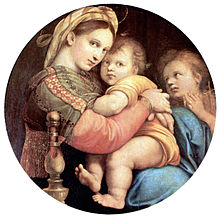Margherita Luti
Margherita Luti , called La Fornarina ( Italian for "the little baker"; * around 1490 in Siena ; † unknown), was the preferred model of the painter Raphael and probably his lover. The picture of the same name, which was created around 1520, is in the Galleria Nazionale d'Arte Antica in Rome .
La Fornarina
Raphael created the highly realistic portrait of the lady with the bared torso in the years 1518/19. The sitter was initially referred to as "Fornarina" (baker's daughter) and was only associated with Margherita Luti in the 19th century, a daughter of the baker Francesco Luti from Siena. At the same time, it was suspected that it was Raphael's lover, although no reliable written sources exist. However, it is generally accepted that there are clear indications of this personal connection. The sitter wears a blue bangle with gold-framed edges on her left upper arm at chest level, into which Raffael has worked the signature RAPHAEL URBINAS. Linana de Girolami Cheney sees this as an indication of a “wedding picture”. Raffael died a year later on his 37th birthday. After Vasari, Margherita Luti was present at Raphael's death, he is said to have left her a considerable sum of money. According to another source, four months after Raphael's death, Luti entered the Congregation of Sant'Apollonia in the Roman district of Trastevere , an institution for fallen but repentant women while the fortune went to Raphael's family.
Margherita Luti
Raphael has given many of his Madonnas the face of Margherita, the baker's daughter. Vasari pointed out that Raphael already 1516 with "La Velata". (also La Donna Velata ) painted a personal portrait of Margherita Luti. The image of the covered beauty measures 85 × 64 cm and is in the possession of the Galleria Palatina in Florence . With La Donna Velata , “[…] the master […] now has a sharpness of characteristics that unites eternal values with the expression of individualization.” Another representation of Luti is the Madonna della seggiola. 1513–1514, oil on panel, 7 × 71 cm, also in the Galleria Palatina, Florence.
Artist love
In addition to Fra Filippo Lippi's (1457–1504) love affair with the novice Lucrezia, the daughter of the Florentine citizen Francesco Buti, Raphael's relationship with Margherita Luti was a romantic symbol of artistic love in art history.
As part of a Raffael cycle, the couple was shown by Jean-Auguste-Dominique Ingres in the painting Raffael et La Fornarina from 1811-1812 , which is in the Fogg Art Museum , Harvard University Art Museum in Cambridge , Massachusetts (USA). Hans Belting assumes that Ingres himself, as a young husband and painter, empathized deeply with the life of his adored role model, Raffael. Pablo Picasso has Raphael and Fornarina in a series of 1968 etchings shown.
In the master novella Raffael and his neighbors published in 1824 , Achim von Arnim processed the story of the beautiful baker - loosely based on Vasari . The American photo artist Cindy Sherman parodied Raphael's work in her work Untitelt # 205 , 1989, in the series of History Portraits .
Web links
- Detail picture of Raffael, La Fornarina. In: Giuseppe Sgarzini: Raffaello. ATS Italia Editrice, 2006, ISBN 88-7571-339-1 , pp. 16/17.
Individual evidence
- ↑ Tobias Burg: The signature: forms and functions from the Middle Ages to the 17th century. Art history. LIT Verlag Berlin / Hamburg / Münster, 2008, ISBN 978-3-8258-9859-5 .
- ↑ Linana de Girolami Cheney, In: Jill Berk Jiminez et al .: Dictionary of Artists' Models. Taylor & Francis, 2001, ISBN 1-57958-233-8 , p. 334.
- ↑ Lloud W. Eshleman: Moulders of Destiny - Renaissance Lives and Times. Read Books, 2007, ISBN 978-1-4067-3880-3 .
- ↑ Germain Bazin , In: Kindler's Painting Lexicon. Volume VI, Kindler, Zurich 1962, p. 463.
- ↑ Luitpold Dussler, In: Kindler's painting Lexicon. Volume V, Kindler, Zurich 1962, p. 18.
- ^ Jacob Burckhardt, Stella von Boch: The altarpiece. The portrait in painting. CH Beck, 2000, ISBN 3-406-44181-5 , p. 179.
- ↑ Hans Belting: The invisible masterpiece: the modern myths of art. CH Beck, 2001, ISBN 3-406-48177-9 , p. 109.
- ^ Pablo Picasso: Raphael et la Fornarina. 1968, etching on artnet
- ↑ Parodies & Variations website
| personal data | |
|---|---|
| SURNAME | Luti, Margherita |
| ALTERNATIVE NAMES | La Fornarina |
| BRIEF DESCRIPTION | Italian model of the painter Raffael and probably his lover |
| DATE OF BIRTH | before 1520 |
| PLACE OF BIRTH | Siena |
| DATE OF DEATH | after 1520 |



